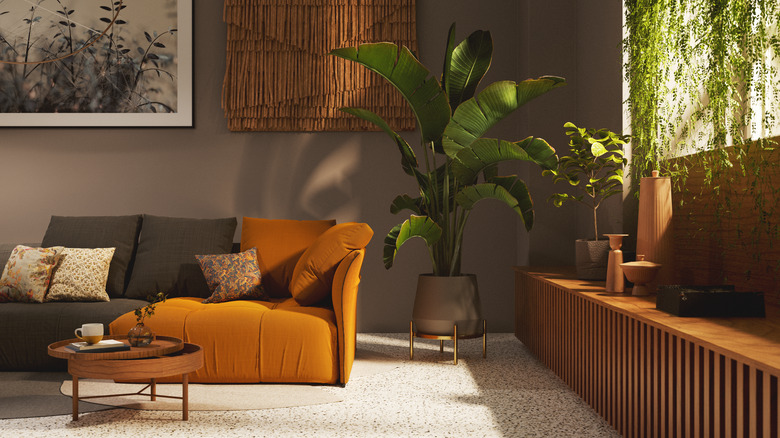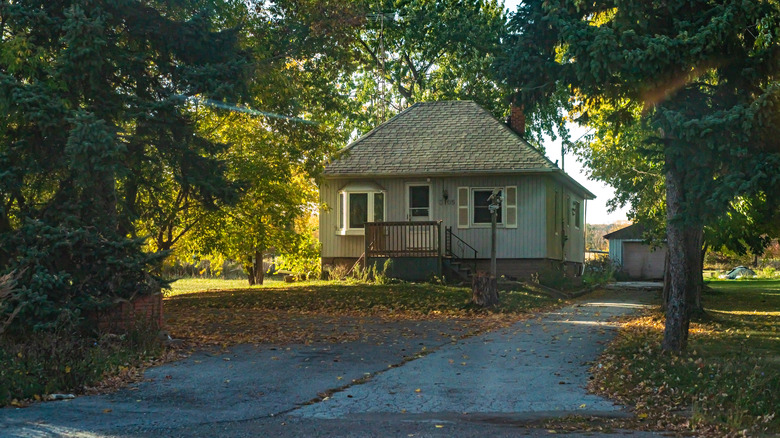Can You Use Plants To Make Your House Feel Cooler In The Summer?
As spring rainclouds give way to summer sunrays, some folks might be excited to don a bathing suit and hit the beach, but for others, rising temperatures are a dreadful reminder that it's time to break out the fan and have your annual HVAC system check. Summer is coming, and whether you love the season or not, keeping the inside of your home cool is a must. Extreme summer temperatures are becoming more common across the United States, prompting many people to crank down their thermostats at the expense of the power grid — and their own wallets. There are other tips you can follow to keep your home cooler, such as closing the blinds and turning fans counterclockwise, but could keeping plants around also help regulate indoor temperatures? Depending on where you place them, it's possible!
You may already be aware that plants can help to improve air quality inside your home or beautify an outdoor space, but some rumors across the internet claim that their natural cooling abilities could also aid your A/C unit. Here's what we know about plants' cooling powers and how they might help you keep cool this summer.
Indoor plants may not help much
Where do these rumors of air-conditioning plants come from? When things heat up, plants release moisture to keep themselves cool, a process known as evapotranspiration. Through the process of transpiration and evaporation, research has shown that plants can also reduce temperatures in their environment. In urban forests, temperatures can be cooler by nearly 3 degrees Fahrenheit, compared to unforested areas (via the U.S. Environmental Protection Agency). However, this doesn't necessarily translate to indoor houseplants because perceived temperature and actual temperature are two different things. Houseplants can increase the humidity in a room, which might make the room feel warmer and stuffier than it actually is — prompting you to bump down the thermostat.
The verdict on indoor plants is that they generally won't help to keep your home cool through evapotranspiration, however, they could keep your home shadier. Placing plants with large, shady leaves near your sunny windows can help filter out some of the heat and sunlight from the window. At the same time, it'll beautify your space without blocking all of the natural light, giving houseplants an aesthetic advantage over curtains or blinds. Try monsteras, hibiscus, fiddle leaf figs, dwarf citrus trees, indoor palm trees, and trailing houseplants.
Outdoor plants can cast major benefits
Just like urban forests help to lower air temperatures through evapotranspiration, having plenty of trees, shrubs, and other foliage can reduce the overall temperature of your yard. If you want to cool your home with plants, growing them outside may prove to be much more effective. Shade trees, shrubs, and lattices with vines can help to cast shade over your home, blocking the sun's rays before they can heat up your roof and walls. While the cooler air temperatures can help your A/C unit not work so hard, don't bother trying to cover it with shade trees. Shading your outdoor unit is a commonly touted tip to prolong the life of your HVAC system, but experts say it won't make much of a difference in energy usage. Instead, focus on shading your yard and home in general, especially near doors and windows where heat can seep through more easily.
According to the U.S. Environmental Protection Agency, growing deciduous trees is the best choice for cooling a building during summer while still allowing sunlight to warm and brighten the home in winter. Look for tall plants with full, shady leaves that will thrive in full sun, such as oak, maple, birch, or elm trees – just be sure to plant them a safe distance away from the home's foundation. Orange jubilee, elephant ear, and climbing trellis vines can also work well to shade south-facing windows.



